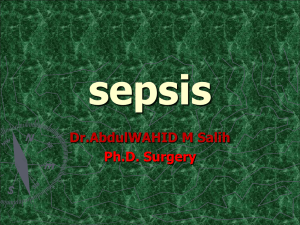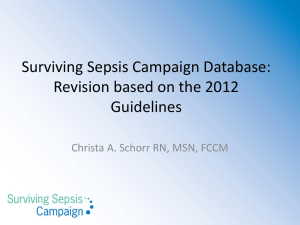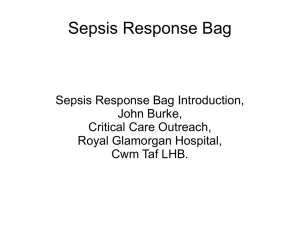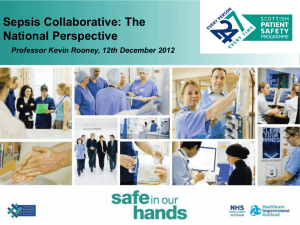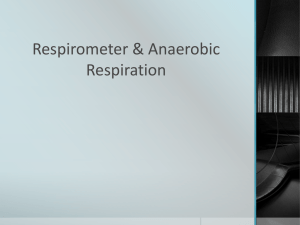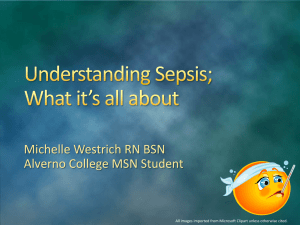Surviving Sepsis Powerpoint
advertisement
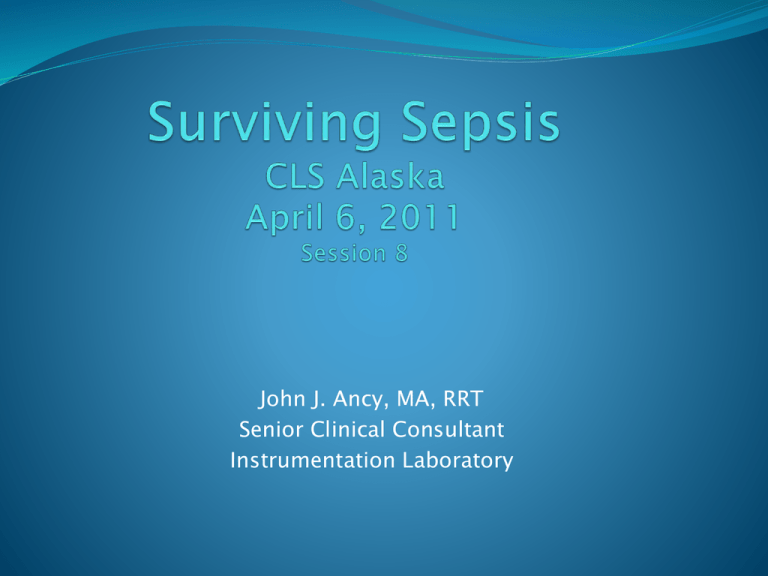
John J. Ancy, MA, RRT Senior Clinical Consultant Instrumentation Laboratory Surviving Sepsis Sepsis, as many deaths as from MI How to improve survival? Rapid accurate diagnosis and treatment (lab tests are critical) Appropriate antimicrobial therapy Compliance with Sepsis Bundles Surviving Sepsis Campaign Worldwide, started in 2001 11medical organizations in 2004 Currently, 18 organizations Goal – reduce mortality by 25% Surviving Sepsis Guidelines First guidelines – 2001 Updated – 2004, 2006 & 2007 Current guidelines – 2008 Graded recommendations Strength of recommendations 1-2 Evidence A-D 1A – 2D Surviving Sepsis Campaign. Crit Care Med 2008; 36:296-327 & 36:13941396. Sepsis Uncontrolled inflammatory response, secondary to infection. 30 to 40% associated with bacteremia Sepsis & Friends Definitions SIRS Sepsis Severe Sepsis Septic Shock MOF (MODS) ALI/ARDS SIRS Systemic Inflammatory Response Syndrome Systemic inflammatory state without proven source of infection Sepsis Sepsis = Infection + systemic manifestations of infection Some manifestations: Fever or hypothermia Elevated HR Tachypnea Arterial hypotension Hypoxemia Hyperlactatetemia Sepsis Inflammatory Variables Leukocytosis WBC > 12000 Leukopenia WBC < 4000 Normal WBC with > 10% immature Plasma C-reactive proteins >2 SD above norm Plasma Procalcitonin > 2SD above norm Early Lab Clues Glucose > 120mg/dL Creatinine increase > 2.0 mg/dL INR > 1.5 or aPTT > 60 sec Thrombocytopenia < 100000 Hyperbilirubinemia > 2 mg/dL Lactate > 1mM/L ? (>2.0) Balk, RA, Dis Mon Apr 2004 50(4): 168-213 Severe Sepsis Sepsis with acute, sepsis-induced organ dysfunction and/or tissue hypoperfusion Septic Shock Sepsis + sepsis-induced hypotension, despite adequate fluid resuscitation MOF/MODS Multiple Organ Failure or Multiple Organ Dysfunction Syndrome ALI/ARDS ALI Acute Lung Inflammation ARDS Acute Respiratory Distress Syndrome SEPSIS is the most common cause of ARDS ALI/ARDS Acute Lung Inflammation Lung inflammation CXR Bilateral diffuse infiltrates No clinical evidence of ▲left atrial pressure or ▼PCWP<18mm Hg P/F ratio 200-300 (PaO2/FiO2) PaO2 100mmHg/ FiO2 0.5 = 200 ALI/ARDS Acute Respiratory Distress Syndrome (Sepsis most common cause) Lung inflammation CXR Bilateral diffuse infiltrates No clinical evidence of ▲left atrial pressure or ▼PCWP<18mm Hg P/F ratio <200 (PaO2/FiO2) PaO2 100mmHg/ FiO2 0.6 = 166 SIRS Mortality Mortality goes up with organ failure 7% SIRS+2 failed organs 10% SIRS+3 17% SIRS+4 Rangel-Frausto, M., Pettet, D., Costigan, M., et. al. The natural history of the systemic inflammatory response syndrome (SIRS). JAMA 273:117-123, 1995 Sepsis Mortality Millions affected worldwide At minimum, 25% mortality (51% in some studies) Epidemiology “Severe sepsis is a common, expensive and frequently fatal condition, with as many deaths as those from acute myocardial infarction” Martin, GS; Mannino, DM; Eaton, S; Moss, M. The Epidemiology of Sepsis in the United States from 1979 through 2000. N Engl J Med. 2003;348: 1546-1554. Epidemiology 2004 Severe Sepsis 750,000 (US) 2010 Severe Sepsis 1,000,000 (US) US cost $16.7 B $22,100 per case Mortality 25% to 51% 210,000 annual deaths (US) Epidemiology Incidence increasing Morbidity/mortality decreasing More common in winter months Sepsis survivors have increased morbidity/mortality for 5 years Curr Pharm Des. 2008; 14 (19): 1833-9 Epidemiology Gram+ most common organisms Majority of infectious sources Pulmonary GI Genitourinary Primary bloodstream Risk Factors Over 65 YOA Male Bacteremia Weakened immune system AIDS, cancer, diabetes or chronic disease Pneumonia Hospitalization Severe traumatic injuries Invasive medical devices Genetic susceptibility Lower socioeconomic status Micro-organisms Bacterial Fungal Viral Protozoan Community Acquired Microorganisms Lung Streptococcus pneumonia Hemophilus influ. Legionella sp Chlamydia pneumonia Abdomen Escherichia coli Bacteroides fragilisn Skin/Soft Tissue Urinary Tract Escherichia coli Klebsiella sp. Enterobacter sp. Polymicrobial Aerobic gr neg Proteus sp. Streptococcus pyogenes Staph. aureus Clostridium sp. Pseudomonas aeruginosa Staph. sp. CNS Streptococcus pneumonia Neiserria meningitidis Listeria monocytogen Escherichia coli Hemophilus influ. Nosocomial Pathogens Lung Aerobic gram negative bacilli Abdomen Aerobic gram neg bac Anaerobes Candida sp. Skin/Soft Tissue Staph. Aureus Aerobic gram negative bacilli Urinary Tract CNS Pseudomonas aeruginosa Escherichia coli Klebsiella sp. Enterococcus Staph. sp Aerobic gram negative bacilli sp. Sepsis Pathophysiology Heterogenous No single mediator/system/pathway/pathogen Derangements involving several organ systems Hyperinflammatory response (commonly), suppressed inflammatory response or mixed response Sepsis Pathophysiology Life threatening changes in coagulation Neutrophils mixed response Apoptosis of lymphocytes/other cells Inflammatory Response Eliminate invading microorganisms without damaging tissues or cells Aberrant Inflammatory Mediator Production “Inflammatory response an important component of sepsis as it drives physiologic responses that result in organ dysfunction.” Remick, DG; Am J Pathol. 2007 May; 170(5); 1435-1444 Hyperinflammatory Response Numerous and plentiful proinflammatory molecules released in sepsis Tumor Necrosing Factor (TNF), interleukins, cytokines and many others elevated Endotoxin elevated = increased inflammatory response Blunt inflammation and save lives? rhAPC-recombinant human activated protein C (Dotrecogen) Blunted Inflammatory Response Studies show that some patients have inhibited proinflammatory response and unabated antiinflammatory response. Failure to control bacteria infection and succumb as a result of immunosuppression rather than immunostimulation. Mixed Inflammatory Response Some studies indicate pathophysiologic contributions from proinflammatory and antiinflammatory mediators Normal Hemostasis Allows blood to remain liquid and flowing and clots to control bleeding Dysregulated Coagulation Coagulation cascade alteration Sepsis patients often have DIC platelet consumption prolonged clotting time microcirculatory clotting profuse bleeding Dysregulated Coagulation Virchow’s Triad Altered coagulation Endothelial cell injury-inflammatory agents Abnormal blood flow Poor tissue perfusion in vital organs Inappropriate O2 delivery/useage Cytopathic hypoxia Lactic acid production Cellular Dysfunction Many cellular aspects are dysfunctional in sepsis (neutrophils) Excessive activation Neutrophils generating excessive inflammatory product damaging nearby cells Depressed function Neutrophil failure to phagocytize Neutrophil activity Neutrophilic function key component of immune response: Neutropenia = infectious complications Overactive neutrophilic activity = hyperinflammatory response In sepsis and other serious illness neutrophil response is very complex and heterogenous. Some patients have excessive response, others blunted activity. Either case results in less effective immune response. Lymphocyte Apoptosis Very pronounced in sepsis Observed in virtually all lymphoid organs Spleen Thymus Gastric tissues Reduces immune response effectiveness Septic Apopotosis Affects many cells/tissues Dendritic cells Macrophages Monocytes Mucosal epithelial cells Endothelial cells Others Altered Metabolism Diabetes of stress (Sepsis) Insulin resistance Hyperglycemia Elevated Glucose Decreased function of polymorphonuclear neutrophils Decreased bactericidal activity Endothelial cell disruption Glycemic Control Reduces infection/faster resolution Improves renal function Reduces muscle wasting Reduces severity and incidence of anemia Protects endothelial cells Improved morbidity and mortality Sepsis Pathophysiology Infection triggers hyperinflammatory response or (blunted response = sepsis) Coagulation dysregulation Lymphocyte & neutorophil dysfunction Microcirculatory and perfusion failure Tissue oxygenation disruption Stress diabetes Sepsis Pathophysiology Tissue and organ failure Pulmonary and peripheral edema Cardiac output is often elevated BP difficult to maintain- extreme vasodilation Maldistribution in microcirculatory beds Higher morbidity/mortality in those with preexisting cardiovascular disease Surviving Sepsis 2008 Graded Recommendations 1.Treatment Emergency Resuscitation (6 Hours) Management ( Within 24 Hours) 2. Supportive Care GRADE Grade Recommendation Assessment Development Evaluation GRADE Surviving Sepsis Recommendations Numerical 1= treatment outweighs harm/burden/costs 2= treatment carries risk/burden/costs Letter A = well documented B = moderate C = low D = very low 2008 GRADE Recommendations 61 recommendations 40 level 1 21 level 2 7 1A recommendations DVT prophylaxis Stress ulcer prophylaxis Ventilator weaning protocol Avoid routine PACs in ALI/ARDS 2008 GRADE Recommendations 16 1B Sedation weaning protocol for vent patients Either crystal or colloid for fluid resuscitation Blood glucose < 150 mg/dL 17 1C Blood cultures before antibiotic therapy Imaging confirmation for infection source Broad spectrum antibiotics within 1hr of sepsis confirmation Treatment A. Initial Resuscitaion B. Diagnosis C. Antibiotic Therapy D. Source Control E. Fluid Therapy Treatment F. Vasopressors G. Inotropic Therapy H. Corticosteroids I. Recombinant Human Activated Protein C J. Blood Product Administration Supportive Care 1. Mechanical Ventilation 2. Sedation, Analgesia, & Neuromuscular 3. 4. 5. 6. 7. Blockade Glucose Control Renal Replacement Bicarbonate Therapy DVT Prophylaxis Stress Ulcer Prophylaxis Initial Resuscitation (1C) Sepsis induced shock Persistent hypotension with fluid admin Lactate > 4.0 mM/L Tx Goals CVP 8-12mm Hg (higher if on ventilator) MAP > 65mm Hg Urine output > 0.5 ml/kg/hr O2 Sat CV > 70% or Mixed Venous > 65% Initial Resucitation If venous saturation is not achieved (2C) Consider more fluid Transfuse packed RBCs to Hct > 30% and/or dobutamine infusion Rationale: increase O2 delivery and CO Diagnosis Cultures before antimicrobial therapy if cultures do not delay antibiotics (1C) Obtain 2 or more Blood Cultures Obtain 1 BC percutaneously Obtain BC from each vascular device in place > 48hr Culture other sites as clinically indicated (preferably quantitative) Diagnosis Rationale: Obtaining BCs peripherally and via access important If same organism, likely sepsis agent If access device organism is + 2hrs before peripheral culture, device is probable source Antibiotic Therapy Antibiotic therapy within 1Hr of recognition Septic shock (1B) Severe sepsis without shock (1D) Obtain appropriate cultures prior to initiating therapy, but should not prevent antimicrobial therapy (1D) Consider premixed antibiotics, bolus admin. for some agents Antibiotic Therapy Initial empirical therapy to include one or more drugs that have activity against likely pathogens (bacterial/fungal) and penetrate into presumed source (1B) Choices are very complex, considerations: Hx, drug intolerances, underlying disease, susceptibility patterns of pathogens, neutropenia, etc. Antibiotic Therapy Empirical continued: Avoid recently used antibiotics MRSA considerations Antifungal therapy (fluconazole, ampho B, echinocandin should be tailored to local pattern of Candida and prior admin. of azoles Severe sepsis or septic shock Broad-spectrum therapy Antibiotic Therapy Further recommendations Duration 7-10 days, longer for slow response, undrainable foci, immunologic deficiencies Stop therapy promptly if proven noninfectious CAUTION: > 50% of blood cultures in severe sepsis or septic shock will be negative for bacteria or fungi Antibiotic Therapy Serum antimicrobial monitoring daily (1C) Rationale: Septic shock/sepsis may inhibit renal and/or hepatic function Abnormal volume distribution due to aggressive fluid therapy Goal: adequate distribution without toxicity Goal: Narrow spectrum and to reduce duration to minimize super-infection, but balance with effective duration Vasopressors Norepinephrine or dopamine firstline vasopressors All patients requiring vasopressors should be monitored with indwelling arterial pressure catheter (1D) Monitor adequacy of perfusion with lactate levels (maintain below 4 mM/L )and urine output Vasopressors Use vasopressors to maintain mean arterial pressure > 65mm Hg (1C) Higher MAP for patient with previously controlled hypertension Lower MAP adequate for young previously normotensive patient Inotropic Therapy Dobutamine infusion for myocardial dysfunction as indicated by elevated cardiac filling pressures and low CO (1C) Septic patients often require vasopressor and inotropic therapy Mechanically ventilated patients with sepsis are particularly at risk for cardiac decompensation. Dotrecogen (Xigris®) recombinant human activated protein C rhAPC FDA approved (some controversy) Anti-inflammatory activity and improved hemostasis Dotrecogen (Xigris®) recombinant human activated protein C rhAPC Consider rhAPC in adults with sepsis induced organ dysfunction or high risk of death (APACHE II > 25) 2B (2C postoperative) Septic patients with low risk ( APACHE < 20 should not receive rhAPC )1A Blood Product Administration RBC transfusion (target Hb 7-9 g/dL) once hypoperfusion, severe hypoxemia, lactic acidosis are resolved (1B) No difference in mortality compared to Hb 10-12g/dL Blood Product Administration Fresh frozen plasma should not be used to correct laboratory clotting abnormalities (increased PT,INR, PTT) in the absence of bleeding (2D) Blood Product Administration Antithrombin administration should not be used in treatment of severe sepsis and septic shock (1B) Studies show mixed mortality and morbidity results Supportive Therapy 1. Mechanical Ventilation 2. Sedation, Analgesia, & Neuromuscular 3. 4. 5. 6. 7. Blockade Glucose Control Renal Replacement Bicarbonate Therapy DVT Prophylaxis Stress Ulcer Prophylaxis Mechanical Ventilation Lung protective ventilation septic ALI/ARDs patients Tidal volume of 6ml/kg for (1B) Plateau Pressure < 30 cm H2O (1C) Permissive hypercapnia to minimize tidal volume and plateau pressure (1C) PEEP to avoid extensive lung collapse (1C) HOB elevated to help prevent VAPs (1B) Sedation, Analgesia & NMBA Sedation and analgesia protocols (1B) Avoid neuromuscular blocking agents if possible (1B) Glucose Control Administer iv insulin for hyperglycemia in severe sepsis (1B) Use glycemic control protocol to maintain glucose < 150 mg/dL (2C) Patients receiving iv insulin and glucose calorie source have glucose level monitored Q2 (1C) Low glucose levels monitored at POC should be interpreted with caution (1B) Bicarbonate Therapy Bicarb therapy should not be used for purpose of improving hemodynamics or reducing vasopressor requirements in patients with hypoperfusion-induced lactic acidemia with pH > 7.15 (1B) Bicarb admin shown to increase Na, lactate, pCO2 decreased iCa, and fluid overload Labs Cultures Antibiotic levels CBC Coagulation Chemistries Blood Gases Renal function & liver function tests Lactate Lactate Lactate is a key indicator of tissue oxygenation. Successful treatment of sepsis requires restoration and maintenance of tissue perfusion and oxygenation. Lactate Normal concentration 0.5 – 2.2 mM/L Normal production 15 – 20 mM/kg day Increases with increased production and/or decreased utilization or clearance (liver failure) Lactate Production & Metabolism Lactate normally produced by RBCs (no mitochondria) During anaerobic metabolism in most tissues (sepsis, cardiac arrest) Kidneys and liver can convert lactate to glucose (gluconeogenesis) Lactate Production & Metabolism Liver lactate metabolism inhibited as lactate increases (as in sepsis) Uptake of lactate by liver inhibited by acidosis, hypoperfusion and hypoxia Lactic Acidosis Type A Decreased tissue perfusion and/or oxygenation Hypoperfusion (decreased CO, hypovolemia, excessive vasoconstriction) Reduced O2 content (hypoxemia, anemia, dyshemoglobinemia) Lactic Acidosis Type B B1 common disorders (liver failure, renal failure, diabetes, cancer, cholera, malaria) B2 drugs and toxins (ethanol, methanol, ethylene glycol, cocaine, zidovudine, acetaminophen, salicylates, catecholamines, niacin and many more) B3 other (seizures, strenuous exercise, status asthmaticus) Lactate Precautions Not specific for perfusion/tissue oxygenation Arterial or mixed venous samples reflect total body lactate Peripheral samples reflect lactate level in limb (influenced by tourniquet, local circulation, etc.) Lactate Precautions Lactate may transiently increase with improvement in circulation Rapid TAT needed (whole blood) Serial sampling very helpful Interpret relative to clinical condition Interpretation of Blood Lactate Results < 2.0 mmol/L: Normal adult at rest 2.1 - 4.0 mmol/L: Moderately elevated > 4.0 mmol/L: Seriously elevated 86 Lactate and Mortality Prolonged elevation of lactate and metabolic acidosis are predictive of higher mortality Lactate greater than 8 mM/L for 2hrs = 90% mortality * *Weil, WM, Affifi, AA. Experimental and Clinical Studies on Lactate and Pyruvate as Indicators of the Severity of Shock. Circulation, 41: 989-1000, 1970. Lactate and Mortality Lactate of > 5mM and pH < 7.35 have mortality of 75% at 6 months Lactate and Sepsis Sepsis induced shock diagnosis includes Lactate > 4.0 mM/L • Monitor adequacy of perfusion with lactate levels (maintain below 4.0 mM/L )and urine output • Effective monitor of tissue oxygenation (lactate < 4.0 mM/L) Serial lactate highly recommended Sepsis Survival Improvement Early and appropriate fluid and blood administration improves outcome Early antibiotic administration with appropriate ongoing management improves outcome (survival decreases by 7.6% for every hour antibiotic therapy is delayed)* *Kumar A, Roberts D, Wood DO, et al.; Crit Care Med 2006;34: 1589-96 Sepsis Survival Improvement Goal of 25% mortality decrease thought to be attainable (210000 to 158000) Surviving Sepsis Recommendations are critical to improved outcome Recommendations continue to evolve Mortality Reduction-2010 Compliance with resuscitation and management bundles 2 year study 165 Sites 15022 subjects Surviving Sepsis Campaign: Results of an international guideline based performance improvement program targeting severe sepsis. Crit Care Med 2010 Vol. 38 No. 2 Mortality Reduction-2010 Guideline Compliance after 2 years Resuscitation bundle increased from 10.9% to 31.3% Management bundle increased from 18.4% to 36.1% Mortality Reduction-2010 2 year reduction Decreased from 37.0% to 30.8% Summary Sepsis is complex with many causes Early and accurate diagnosis are essential Lab tests need quick TAT Adherence to resuscitation and management bundles reduces mortality (2010 study) Goal of 25% mortality decrease thought to be attainable (210000 to 158000) Surviving Sepsis Guidelines continue to evolve
